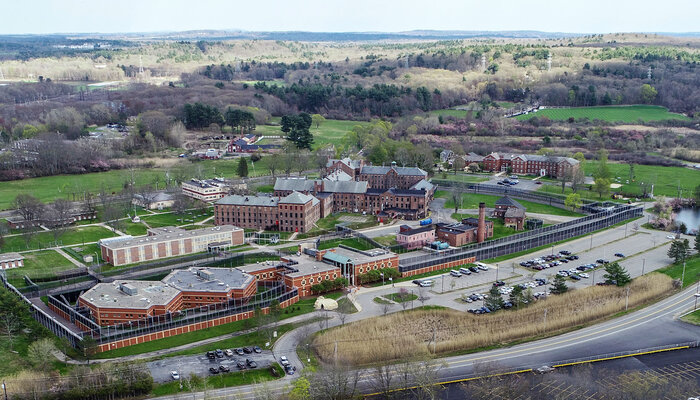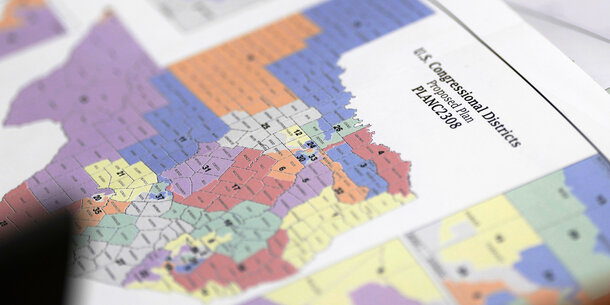The U.S. Census Bureau recently released 2020 redistricting population data, setting off the redrawing of congressional, state, and local electoral maps around the country. When reporting this data, the Census Bureau generally locates people where it deems them to “live and sleep most of the time.”1 For people in prison, this means the site of their incarceration rather than their home communities, even though in most cases they have no meaningful connection to that area. 2 The policy wrongly suggests that people in prison are “at home” where they are incarcerated, ignoring that most stays in prison are far shorter than the decade for which the maps will be in effect 3 and that many states consider incarcerated people legally resident in their home communities for purposes other than redistricting. 4
While some states reallocate incarcerated individuals to their home communities when making maps, most do not. When states draw districts without reallocating people who are incarcerated, they ignore the reality of the relationship between these individuals and the areas where prisons are located. Lawmakers who represent those areas often do not feel the same responsibility toward people in prison that they do for their other constituents and generally do not inquire about their welfare or represent their interests. 5 Incarcerated individuals have much more meaningful connections to their home communities and the lawmakers who represent those areas, some of whom even perform constituent services on their behalf. 6 But those areas see their representation in legislative bodies diluted, while areas with prisons receive more than their fair share. This practice is known as prison gerrymandering, and it turns inequities in our criminal justice system into representational inequities.
Prison gerrymandering undermines our democracy in several key ways:
- It presents a distorted snapshot of the general population and misrepresents incarcerated peoples’ relationship to their representatives. Incarcerated individuals generally have few connections to the areas housing prison facilities, which are often far from their home communities and demographically very different from them. 7 Most people in prison at the time the census is taken will be released within three years, and exceedingly few remain near the prison upon release, yet they will be counted toward that region’s representation for the full decade that the maps are in effect. 8 Evidence from legislators and legislative staffers suggests that the lawmakers who represent these districts do not always consider incarcerated people to be “real constituents” and are often indifferent to their interests. 9 When incarcerated individuals do receive constituent services, they are often provided by representatives from their home communities, as legislators from Philadelphia and Houston have attested. 10
- Black and Latino communities are deprived of representation. These communities of color are incarcerated at disproportionate rates nationwide. In 2019, 56 percent of the United States’ prison population was Black or Latino, despite these groups making up only 32 percent of the overall population. 11 Prison gerrymandering turns disparities in incarceration into disparities in representation; electoral maps do not reflect the true size of the largely Black and Latino urban communities. 12 For example, according to the Texas Civil Rights Project, Harris County (containing the city of Houston) and Dallas County would likely have received an additional state house seat each if incarcerated people were counted at their homes. 13 While these inequities have long existed, they have become magnified with the rise of mass incarceration starting in the 1970s. 14
- The largely rural, white communities where prisons are located receive a representation windfall. In most states, prison facilities are located in rural areas with predominantly white populations. 15 Because the law requires districts to be roughly equal in population size, without the incarcerated population many of these districts would have fewer people than legally required and would have to be expanded. 16 By counting incarcerated individuals at prisons, states artificially inflate these areas’ populations, and thereby their political clout. The Prison Policy Initiative reported that in Texas, for example, every 88 people in two districts with prisons received as much representation as every 100 people elsewhere in the state. 17 Prison gerrymandering not only skews representation away from the urban communities from which incarcerated individuals overwhelmingly come but also from rural communities that do not host prison facilities. 18
- Prison gerrymandering compounds other forms of discrimination. The systemic underrepresentation of Black and Latino communities in Congress and state legislatures gives them less of a say in how resources are allocated. In this way, prison gerrymandering exacerbates harms caused by other forms of gerrymandering and abuses like vote suppression, which also tend to target Black and Latino people and other communities of color. 19
Thankfully, public support for ending prison gerrymandering is burgeoning. In 2016, the Census Bureau considered a change to its residence rule that would have counted incarcerated persons in their home communities. Although the bureau chose ultimately not to change the rule for the 2020 Census, it received an overwhelming 77,863 comments supporting the change. 20 And a growing number of bills have been introduced in Congress that would mandate a change to how incarcerated people are counted.
Even if there is no change at the federal level, there is much work that can be done by the states. The Census Bureau offered a new data product this year that will help states allocate incarcerated individuals to their home communities for this redistricting cycle. 21 To date, 11 states have permanently changed their policies on where people who are incarcerated will be counted for purposes of redistricting. 22 Additionally, Pennsylvania’s redistricting commission recently voted to do so for the current cycle. 23
This map provides imprisonment rates for each state, in the majority of which prison gerrymandering remains the norm. The following table highlights the twelve states that have passed reform, breaking down the status of the reform in each state and providing basic demographic data of the prison population.24
Endnotes
-
1
Final 2020 Census Residence Criteria and Residence Situations, 83 Fed. Reg. 5525 (Feb. 8, 2018) (to be codified at 15 C.F.R. ch. 1), https://www.govinfo.gov/content/pkg/FR-2018–02–08/pdf/2018–02370.pdf. -
2
In this way, the relationship between incarcerated individuals and communities containing prison facilities is not analogous to that of college students or members of the armed forces, who interact with the communities they temporarily find themselves in. -
3
See Danielle Kaeble, “Time Served in State Prison, 2016,” Bureau of Justice Statistics, November 29, 2018, https://www.bjs.gov/index.cfm?ty=pbdetail&iid=6446. -
4
Alaa Chaker, “Prison Malapportionment: Forging a New Path for State Courts,” Yale Law Journal 130 (March 2021): 1274–75, https://www.yalelawjournal.org/comment/prison-malapportionment-forging-a-new-path-for-state-courts. Alaska, Arizona, California, Colorado, Connecticut, Hawaii, Idaho, Maine, Michigan, Minnesota, Mississippi, Missouri, Montana, Nevada, New Hampshire, New Mexico, New York, Oregon, Pennsylvania, Rhode Island, Texas, Utah, Vermont, Washington, and Wyoming all have state statutes or constitutional provisions that expressly state that a person does not gain or lose residence by reason of incarceration at a prison or institution. Id. at note 131. -
5
See Sam Roberts, “Census Bureau’s Counting of Prisoners Benefits Some Rural Voting Districts,” New York Times, October 23, 2008, http://www.nytimes.com/2008/10/24/us/politics/24census.html. -
6
See Jonathan Lai, “How ‘Prison Gerrymandering’ Shifts Political Power from Urban Pennsylvanians of Color to White, Rural Ones,” Philadelphia Inquirer, July 11, 2019, https://www.inquirer.com/politics/pennsylvania/prison-gerrymandering-pa-2021-redistricting-census-20190725.html; and Jonathan Tilove, “Prisoners Can’t Vote, but They Can Subtly Shift Political Power,” Austin American-Statesman, updated September 25, 2018, https://www.statesman.com/article/20131201/NEWS/312019821. -
7
In the state of New York, “70% of all state inmates are placed in prisons 100 miles or more away from their homes, and 58% of all prisoners from New York City are incarcerated in prisons 200 miles or more from their homes.” Elana Confino-Pinzon, “Locked Up Far Away From Home: The Problem of Distance in New York State Prisons,” Brown Political Review, March 30, 2019, https://brownpoliticalreview.org/2019/03/locked-far-away-home-problem-distance-new-york-state-prisons. -
8
See, e.g., Kaeble, “Time Served in State Prison, 2016” (76.8 percent of all incarcerated people and 56.7 percent of those serving time for violent offenses spend less than three years in prison); and Timothy Hughes and Doris James Wilson, “Reentry Trends in the United States: Inmates Returning to the Community After Serving Time in Prison,” Bureau of Justice Statistics, April 14, 2004, https://bjs.ojp.gov/content/pub/pdf/reentry.pdf (95 percent of incarcerated people will be released at some point). -
9
See, e.g., Roberts, “Census Bureau’s Counting of Prisoners Benefits Some Rural Voting Districts” (quoting an Iowa state representative as saying “not really” when asked whether he considered incarcerated people to be residents); and Todd A. Breitbart to Karen Humes, July 18, 2015, Comment on the 2020 Decennial Census Residence Rule and Residence Situations Docket No. 150409353–5353–01, at 2, http://www.prisonersofthecensus.org/letters/Todd_Breitbart_comment_letter.pdf (legislators “do not offer the prisoners the ‘constituent services’ that they provide to permanent residents of their districts”). See also Justin Levitt, July 20, 2015, Comment on Census Residence Rule and Residence Situations: People in Correctional Facilities, at 4, https://redistricting.lls.edu/wp-content/uploads/2015-census-residence-comment.pdf; and Sherrilyn Ifill to Karen Humes, September 1, 2016, June 30, 2016 Federal Register notice regarding the Residence Rule and Residence Situations, 81 FR 42577, at 4 , https://www.naacpldf.org/wp-content/uploads/NAACP-LDF-Letter-to-Chief-Humes-of-the-Census-Bureau_0–1.pdf. -
10
Lai, “How ‘Prison Gerrymandering’ Shifts Political Power” (quoting Pennsylvania State Rep. Joanna McClinton (D-Philadelphia): “We literally are still doing constituent services for them, but still they are not counted as in our districts.”); and Tilove, “Prisoners Can’t Vote” (noting that Texas State Rep. Harold Dutton (D-Houston) had a staffer dedicated to constituent requests from inmates from his district incarcerated elsewhere). -
11
E. Ann Carson, “Prisoners in 2019,” Bureau of Justice Statistics, October 2020, table 3, https://bjs.ojp.gov/content/pub/pdf/p19.pdf. -
12
Brianna Remster and Rory Kramer, “Shifting Power: The Impact of Incarceration on Political Representation,” Du Bois Review: Social Science Research on Race 15, no. 2 (2018): 417–39, https://doi.org/10.1017/S1742058X18000206 (finding that if Pennsylvania ended prison gerrymandering, over 100,00 Black Philadelphians would live in overpopulated districts, while three out of the four overpopulated districts would be majority-minority); Ross Ramsey, “Playing the Inmate Card Skews Redistricting,” Texas Tribune, September 29, 2011, https://www.nytimes.com/2011/09/30/us/for-redistricting-texas-counts-prisoners-where-they-sleep.html (reporting that Harris County, which includes Houston, would be entitled to an additional legislative district if incarcerated people were counted at their home addresses). -
13
Joaquin Gonzalez et al., Prison Gerrymandering Report 2021, Texas Civil Rights Project, 2021, https://txcivilrights.org/wp-content/uploads/2021/04/Prison_Gerrymandering_Report.pdf (describing how prison gerrymandering resulted in Harris County losing one seat in the Texas House of Representatives); and Sanya Mansoor and Madeleine Carlisle, “How Prison Gerrymandering Distorts Political Representation,” Time, July 1, 2021, https://time.com/6077245/prison-gerrymandering-political-representation (citing Joaquin Gonzalez: “Both Harris County (home to Houston) and Dallas County would also likely have at least one extra state House seat if they counted incarcerated people at home.”). -
14
See James Cullen, “The History of Mass Incarceration,” Brennan Center for Justice, July 20, 2018, https://www.brennancenter.org/our-work/analysis-opinion/history-mass-incarceration. -
15
See, e.g., Peter Wagner, “Breaking the Census: Redistricting in an Era of Mass Incarceration,” William Mitchell Law Review 38, no. 4 (2012): 1244, https://open.mitchellhamline.edu/wmlr/vol38/iss4/9/ (noting that “[v]irtually all — 98% — of New York state’s prison cells were located in state senate districts that are disproportionately White”). -
16
For example, researchers at the Texas Civil Rights Project found that “if its prison population were removed, Texas House District 8, for example, would ‘lose’ 21,112 residents, making it 12.59% smaller than the average state house district.” Gonzalez et al., Prison Gerrymandering Report 2021, 5. -
17
“In two districts (District 13 near Walker County and District 8 near Anderson County) almost 12% of each district’s 2000 Census population is incarcerated. Effectively each group of 88 actual residents in these two districts is given as much political clout as 100 people elsewhere in Texas.” Prison Gerrymandering Project, “Texas 2010 Census Guide,” Prison Policy Initiative, March 2010, https://www.prisonersofthecensus.org/50states/TX.html. -
18
“This relative over-representation, occurring in a handful of districts, not only distorts the balance of power between urban and rural counties, but also gives a few rural communities greater representation in the legislature than the rest of rural Texas. In particular, rural West Texas, which faces unique issues such as drought and access to health care, gets proportionally far less representation in legislative districts than rural East Texas.” Gonzalez et. al, Prison Gerrymandering Report 2021, 5. -
19
See, e.g., Jonathan Brater, Kevin Morris, Myrna Pérez, and Christopher Deluzio, Purges: A Growing Threat to the Right to Vote, Brennan Center for Justice, July 20, 2018 https://www.brennancenter.org/sites/default/files/2019–08/Report_Purges_Growing_Threat.pdf (finding that racial minorities were more likely than white people to be incorrectly purged by the Interstate Voter Registration Crosscheck Program because of common surnames); and Keesha Gaskins and Sundeep Iyer, The Challenge of Obtaining Voter Identification, July 18, 2012, https://www.brennancenter.org/sites/default/files/2019–08/Report_Challenge_of_Obtaining_Voter_ID.pdf (finding that racial minorities are less likely to have the types of identification required by restrictive voter ID laws and that they face barriers in obtaining the proper ID). -
20
Final 2020 Census Residence Criteria and Residence Situations at 5527. -
21
Samantha Osaki, Lalita Moskowitz, and Mario O. Jimenez, “New Census Bureau Data Offers a Chance to Dismantle Prison Gerrymandering,” ACLU, June 21, 2021, https://www.aclu.org/news/prisoners-rights/new-census-bureau-data-offers-a-chance-to-dismantle-prison-gerrymandering/; and Final 2020 Census Residence Criteria and Residence Situations. -
22
California, Colorado, Connecticut, Delaware, Illinois, Maryland, Nevada, New Jersey, New York, Virginia, and Washington have ended prison gerrymandering. Ben Williams, “Reallocating Inmate Data for Redistricting,” National Conference of State Legislators, September 22, 2021, https://www.ncsl.org/research/redistricting/reallocating-incarcerated-persons-for-redistricting.aspx. -
23
Mark Scolforo, “Assembly Map-Drawing Panel to Count Inmates in Home Towns,” Associated Press, August 24, 2021, https://apnews.com/article/prisons-redistricting-a353d8ef6295b62e8dd835a92fb96a6e. -
24
“State-by-State Data,” The Sentencing Project, 2019, https://www.sentencingproject.org/the-facts/#map?dataset-option=SIR; “Total Number of People in Local Jails and State Prisons,” Vera Institute of Justice, 2018, https://www.vera.org/publications/state-incarceration-trends; Ashley Nellis, “The Color of Justice: Racial and Ethnic Disparity in State Prisons,” The Sentencing Project, 2021, https://www.sentencingproject.org/publications/color-of-justice-racial-and-ethnic-disparity-in-state-prisons/




